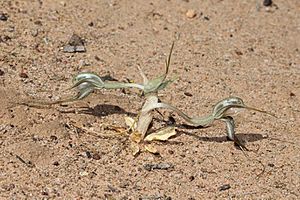Lowly rustyhood facts for kids
Quick facts for kids Lowly rustyhood |
|
|---|---|
 |
|
| Pterostylis despectans growing near Inglewood in Victoria | |
| Conservation status | |
| Scientific classification | |
| Genus: |
Pterostylis
|
| Species: |
despectans
|
| Synonyms | |
|
|
The lowly rustyhood (scientific name: Pterostylis despectans) is a special type of orchid plant. It is found only in south-eastern Australia. This unique plant is known for its flowers that look a bit like insects. These flowers often touch the ground. The lowly rustyhood has a group of leaves at its base. It can grow up to six flowers on long stalks that branch off a short stem.
Contents
What Does the Lowly Rustyhood Look Like?
The lowly rustyhood is a plant that grows from an underground tuber (like a small potato). It is a perennial plant, meaning it lives for more than two years. It is also deciduous, so its leaves might wither away.
At the bottom of its flowering stem, it has a rosette (a circular cluster) of six to ten leaves. Each leaf is about 10 to 20 mm (0.4 to 0.8 in) long and 6 to 8 mm (0.2 to 0.3 in) wide. Often, these leaves have already withered by the time the plant flowers.
The plant grows a flowering stem that is about 30 to 50 mm (1.2 to 2.0 in) tall. On this stem, it can have up to six flowers. These flowers are partly see-through and have green and brown markings. Each flower is about 30 to 38 mm (1.2 to 1.5 in) long and 6 to 8 mm (0.2 to 0.3 in) wide. Each flower grows on the end of a long, thin stalk.
The flowering stem has three or four papery bracts wrapped around it. The top sepal (part of the flower) and petals join together to form a hood called the "galea." This galea covers the central part of the flower. The top sepal has a thread-like tip that is about 10 to 13 mm (0.4 to 0.5 in) long. The side sepals are a bit wider than the galea and often touch the ground. They are slightly curved and have tiny hairs on their outer edges. They also have a thread-like tip, which is about 20 to 26 mm (0.8 to 1.0 in) long.
The most interesting part is the labellum, which is like the orchid's "lip." It is brown to green, thin, and looks like an insect. It is about 5 mm (0.2 in) long and 2 mm (0.08 in) wide. The "head" end of the labellum has two long bristles. There are also 10 to 16 shorter bristles along its sides. The lowly rustyhood flowers from November to December.
How it Got its Name
The lowly rustyhood was first officially described in 1950 by a scientist named William Nicholls. He first called it Pterostylis rufa var. despectans. He published his description in a science journal called The Victorian Naturalist. The first plant specimen used for this description was found near Maryborough in Victoria.
Later, in 1989, two other scientists, Mark Clements and David Jones, decided that it was unique enough to be its own species. So, they gave it its current name, Pterostylis despectans.
Where Does it Live?
The lowly rustyhood is found in only a few specific places in three Australian states.
- In New South Wales, there is only one known group of these plants. They grow in grassland near Moama in the Riverina area.
- In Victoria, you can find it in forests near Maryborough, grasslands near Bendigo, and woodlands near Horsham.
- In South Australia, it grows in parts of the Northern Lofty plant region.
Protecting the Lowly Rustyhood
The lowly rustyhood is a very rare plant, and it needs our help to survive. It is classified as "endangered" in several places:
- Under the Victorian Government's Flora and Fauna Guarantee Act 1988.
- In South Australia.
- Under the Australian Government's Environment Protection and Biodiversity Conservation Act 1999 (EPBC Act).
It is even considered "critically endangered" in New South Wales, which means it is at very high risk of disappearing forever.
The main reasons why this orchid is in danger are:
- Habitat loss and fragmentation: This means the places where it lives are being destroyed or broken up into smaller pieces.
- Invasive species: Other plants or animals that are not native to the area can take over and harm the orchid's environment.
- Low reproduction rates: The plant does not produce many new plants, making it harder for its population to grow.


